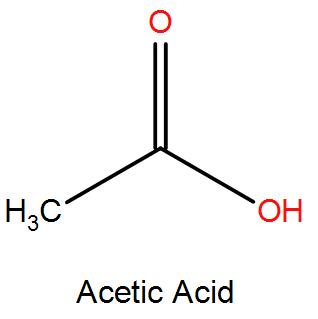
The basicity of acetic acid is:
A.1
B.2
C.3
D.4
Answer
121.5k+ views
Hint: We know that the basicity of an acid is the number of replaceable hydrogen atoms that are present in a molecule of that acid. Hence an acid that contains only one replaceable hydrogen atom in its molecule is known as a monobasic acid and its basicity is 1. Similarly, the acid which contains two replaceable hydrogen atoms in its molecule is called a dibasic acid and its basicity is 2. With this concept in mind, we will be solving the given question where we have to first know about the molecular structure of Acetic Acid and then find how many hydrogen atoms it replaces to find its basicity.
Step by step answer: Acetic Acid has a total of 4 hydrogen atoms and 2 carbon atoms with functional group oxygen present in its molecular structure as we can see below. The dissociation formula of acetic acid is also given as follows:
$\text{C}{{\text{H}}_{3}}-\text{COOH }\xrightarrow{{}}\text{ C}{{\text{H}}_{\text{3}}}\text{CO}{{\text{O}}^{-}}\text{ }+\text{ }{{\text{H}}^{+}}$

4 hydrogen atoms being present in the molecule of Acetic Acid, it only has one replaceable hydrogen ion present in it. Hence giving only one ionizable ${{\text{H}}^{+}}$ ion, hence its basicity is 1.
So we can determine that the basicity of Acetic acid is 1 because it releases one hydrogen ion in an aqueous solution.
Therefore, the correct option is Option A.
Note: The less electronegative the element, the less stable the lone pair will be and therefore the higher will be the basicity. Even though it’s a weak acid, at high concentrations it will be corrosive on skin. The household vinegar consists of Acetic acid as a primary ingredient.
Step by step answer: Acetic Acid has a total of 4 hydrogen atoms and 2 carbon atoms with functional group oxygen present in its molecular structure as we can see below. The dissociation formula of acetic acid is also given as follows:
$\text{C}{{\text{H}}_{3}}-\text{COOH }\xrightarrow{{}}\text{ C}{{\text{H}}_{\text{3}}}\text{CO}{{\text{O}}^{-}}\text{ }+\text{ }{{\text{H}}^{+}}$

4 hydrogen atoms being present in the molecule of Acetic Acid, it only has one replaceable hydrogen ion present in it. Hence giving only one ionizable ${{\text{H}}^{+}}$ ion, hence its basicity is 1.
So we can determine that the basicity of Acetic acid is 1 because it releases one hydrogen ion in an aqueous solution.
Therefore, the correct option is Option A.
Note: The less electronegative the element, the less stable the lone pair will be and therefore the higher will be the basicity. Even though it’s a weak acid, at high concentrations it will be corrosive on skin. The household vinegar consists of Acetic acid as a primary ingredient.
Recently Updated Pages
Types of Solutions - Solution in Chemistry

Difference Between Crystalline and Amorphous Solid

JEE Main Participating Colleges 2024 - A Complete List of Top Colleges

JEE Main Maths Paper Pattern 2025 – Marking, Sections & Tips

Sign up for JEE Main 2025 Live Classes - Vedantu

JEE Main 2025 Helpline Numbers - Center Contact, Phone Number, Address

Trending doubts
JEE Mains 2025: Check Important Dates, Syllabus, Exam Pattern, Fee and Updates

JEE Main Login 2045: Step-by-Step Instructions and Details

JEE Main Chemistry Question Paper with Answer Keys and Solutions

JEE Main Exam Marking Scheme: Detailed Breakdown of Marks and Negative Marking

JEE Main 2023 January 24 Shift 2 Question Paper with Answer Keys & Solutions

JEE Main Chemistry Exam Pattern 2025

Other Pages
NCERT Solutions for Class 11 Chemistry Chapter 7 Redox Reaction

NCERT Solutions for Class 11 Chemistry Chapter 5 Thermodynamics

NCERT Solutions for Class 11 Chemistry Chapter 8 Organic Chemistry

NCERT Solutions for Class 11 Chemistry Chapter 6 Equilibrium

NCERT Solutions for Class 11 Chemistry Chapter 9 Hydrocarbons

JEE Advanced Marks vs Ranks 2025: Understanding Category-wise Qualifying Marks and Previous Year Cut-offs




